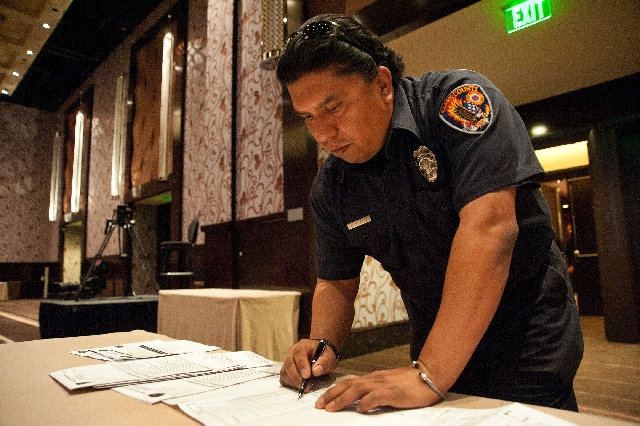Clark County fire inspectors’ time in the field comes under scrutiny
Clark County fire inspector vehicles are in the field for only about four hours each day during a 10-hour shift, according to a county report obtained by the Review-Journal.
For county building inspectors, the average time in the field is a little more than six hours during an 8½-hour shift, according to county data. The data comparing inspectors’ field time is based on a month’s worth of GPS tracking information in county vehicles from February.
The difference outlined between the Fire Prevention Bureau and the Building Department will come before county commissioners today .
Commissioners are expected to vote on a proposal to merge the Fire Prevention Bureau with the Building Department, putting it under building official Ron Lynn instead of Fire Chief Bertral Washington.
“The GPS numbers are troubling in terms of being efficient,” Commission Chairman Steve Sisolak said in an interview.
But the proposed merger has generated concerns among fire inspectors. They worry about less communication between inspectors and firefighter crews.
Also of concern is the Fire Department and fire chief having a diminished role in fire code decisions, such as those affecting hydrants and water supplies.
Fire inspectors work primarily from fire stations next to fire suppression crews, and a merger could result in some or all of the county’s 42 fire inspectors moving to the Building Department, at 4701 W. Russell Road.
The county’s data on fire inspectors tracked GPS in 26 out of the 42 inspectors’ vehicles. In general, fire inspectors work 10-hour shifts, from 7 a.m. to 5 p.m., with an hour for lunch. Building inspectors have half-hour lunch break during their 8½-hour shift.
The result: Fire inspectors’ vehicles are in the field for four hours and one minute during each 10-hour shift they are in use. That period accounts for inspectors’ drive time to and from fire stations and the time they spend on inspections.
Fire inspectors aren’t named in the report, though the data breaks down the time spent in the field individually.
On the low end, one fire inspector’s vehicle averaged an hour and 26 minutes a day in the field. On the high end, another fire inspector averaged six hours and one minute of each shift in the field.
Half of the inspectors — 13 — were in the field for four to five hours per shift.
“Some of those numbers are so low — a couple of hours a day — it’s concerning,” Sisolak said.
He added: “When it’s pretty regular, you wonder about the level of supervision that they’re able to achieve while they’re under the fire chief. It’s extremely troubling.”
FIRE CHIEF’S RESPONSE
Washington said he received the report late last week and was still going through the GPS data. While stressing that it’s too soon to reach a conclusion, he said there are variables to keep in mind that won’t emerge from the GPS data.
In one case in which the data showed an inspector in the field for only a couple of hours, the person was off work, Washington said. In another case, on a day with a short shift in the field, the inspector left work early because of an illness, he said.
“There’s other data I think we have to take our time and look at to verify whether the GPS data is an accurate indicator of the workload of an employee,” he said.
Also, the vehicle fleet is downsized and fire inspectors work four-day weeks. Vehicles are sometimes shared among other fire prevention employees, including staff who aren’t inspectors, Washington said.
Washington stressed that it was too soon to make a sweeping judgment about the data, which his department was still analyzing and reviewing.
Donna Starkes, a deputy fire marshal with the Fire Prevention Bureau, said a fire inspector’s day consists of much more than fieldwork. Inspectors also have to complete paperwork, do code research and work on data entry, calling contractors to confirm times for inspections, she said.
There are other considerations as well, she said. Inspectors carpool to staff meetings and big inspections requiring more than one staffer, she said.
Location also matters. In some cases, a staffer can quickly do 20 inspections centered in a large business complex, then spend the rest of the day in the office completing the reports, she said.
Lynn didn’t respond to a request for comment.
If commissioners approve the merger, the marriage of fire prevention and the Building Department will be guided by a memorandum of understanding between the fire and building departments.
That agreement has the following requirements:
■ The fire chief will participate in recommending any fire code changes to the commissioners.
■ The fire chief will have the authority to present code changes on his own directly to commissioners if they directly affect areas such as Fire Department access, water supply, emergency preparedness, and fire suppression and investigations.
■ Training and communications will take place between fire prevention staff and fire suppression crews through periodic meetings and electronic communications.
Contact reporter Ben Botkin at bbotkin@reviewjournal. com or 702-455-4519.























